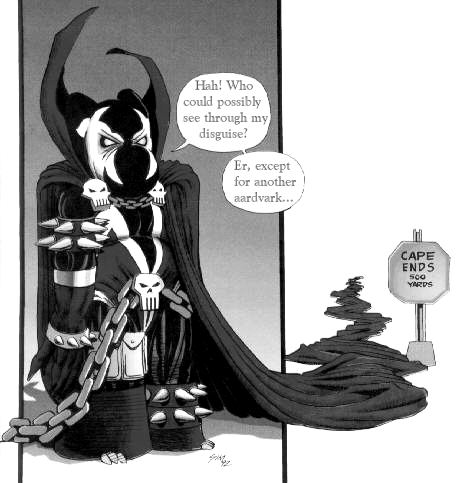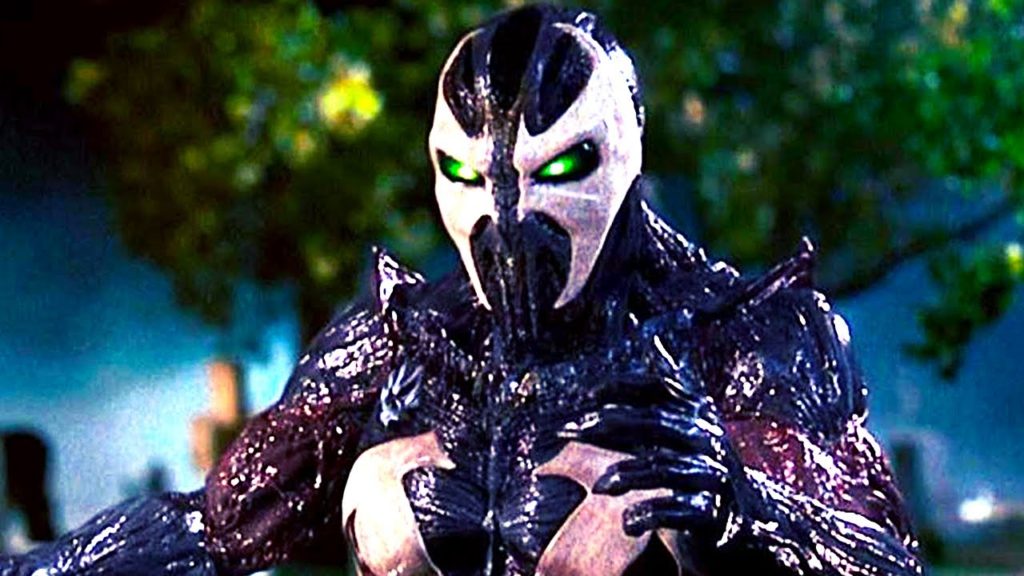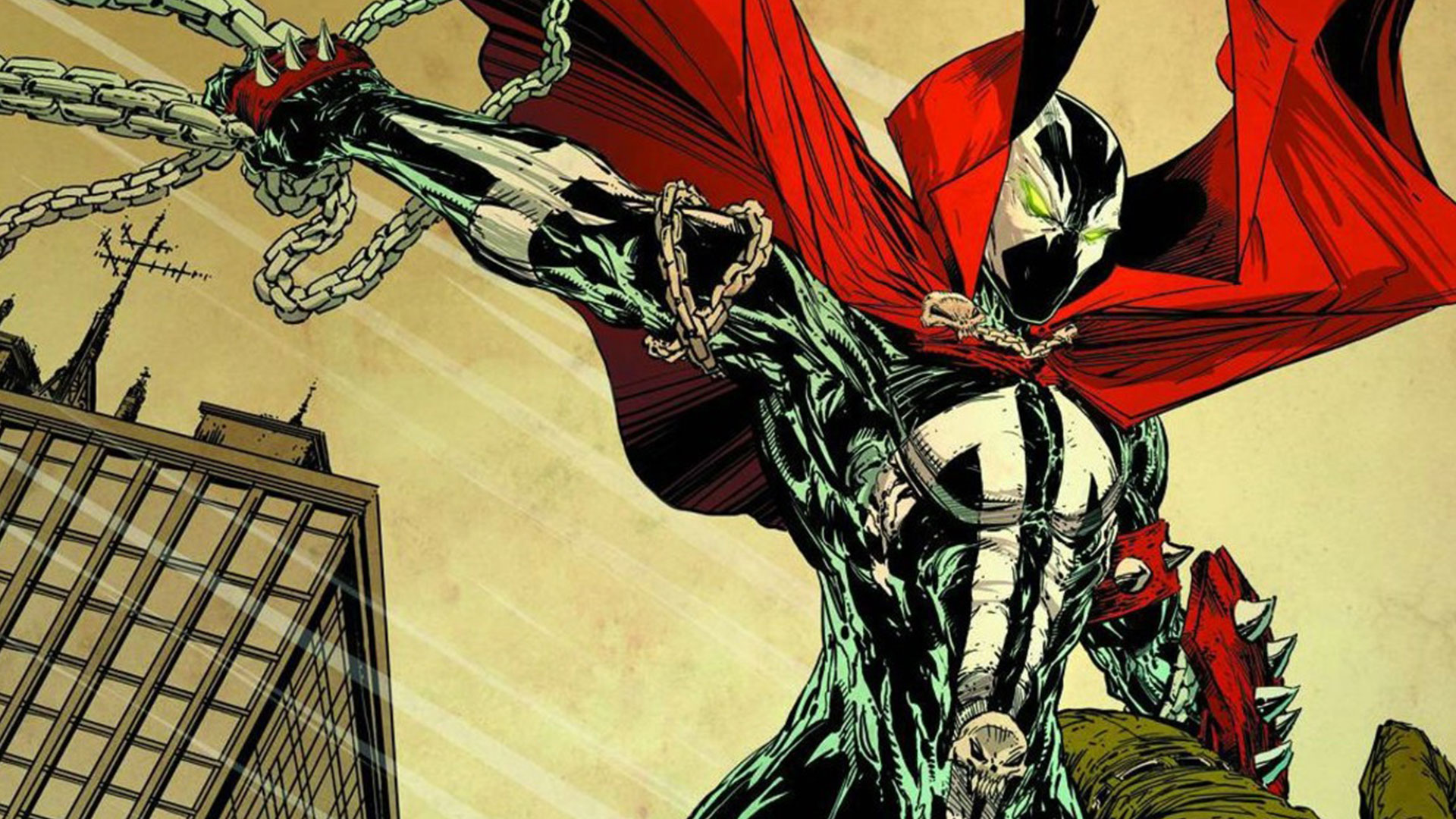Life’s a Riot With Spawn vs. Spawn…
While we’ve compared live-action and animated versions of movies before – Wicked City, The Guyver and City Hunter – with Spawn, it’s the first time two have come out so close together. Both are very much driven by Todd McFarlane, creator of the original comic-book: he’s been able to keep a firm hand on the tiller because, as he says, “what could Hollywood offer me except fortune and fame?”, and as creator of the top-selling comic in America, he already had plenty of both. Though it seems odd he authorised two such similar projects the same year. The common plot has government killer Al Simmons’ resurrected as Spawn, and follows as he comes to terms with his new role in Hell’s army, resulting from a demonic pact accepted after his death. He wants to break the contract, but where can a horribly disfigured dead man go? Certainly not back to his wife, now married to Al’s best friend and with the daughter she long craved. He also has to deal with the Clown, a satanic mentor who keeps an eye on Spawn to snuff out any signs of goodness.
The HBO animated series was first and is undeniably grittier, meriting an ‘R’, especially in the video version. In it, Spawn becomes entangled with the mob, intelligence community, and the child-killing relative of a US senator who wants to be the president. You’ll hear familiar voices, notably Ronnie Cox as both Senator McMillan and the psychopathic Billy Kincaid, and Mike McShane, cast heavily against type as a seven-stone weakling [The only way to keep him in character was to make him stand motionless, arms by his sides — as soon as he moved, he started to lose it!] William Hurt was originally down as narrator Cogliostro, but a throat infection ruled him out, so the part went to Richard Dysart, who played Doc Copper in The Thing. In one of those coincidences, that film marked the debut of actor David Keith as Childs. 15 years later, Keith and Dysart are reunited, since the former is the voice of Spawn…

Enough name-dropping; is it any good? Well, from the very start, it’s patently obvious that Spawn certainly ain’t no Disney film; not with the amount of body fluids, nudity and swear words which are spattered around. This is done in a refreshingly gleeful manner that evokes anime more than any American TV show — even one intended for broadcast on cable at midnight. The animation is decent enough, if not exceptional; though there are times when the Korean studio occasionally forget they are no longer working on My Little Pony, the storyline and voice acting manage to hold your interest, and there’s an appealing, bone-dry humour which runs through much of the script. The various facets of the production build upon and support each other, making the end result probably better than the sum of its parts. The atmosphere is heavily aided by Shirley Walker’s score, which rumbles along ominously in the background, distinctly reminiscent of the soundtrack to computer slaughterfest Doom.
There are loose ends flailing, notably a Spawn-hunter named Angela who turns up, kicks ass and then vanishes from the storyline. One presumes she’ll re-appear in the second series, to which the end of the sixth episode points unsubtly. But McFarlane manages to avoid the obvious clichés of an episodic structure — they don’t all have to end with a big battle, and watching the compiled version, it’s almost impossible to tell where one part stops and the next begins. Overall, it’s striking, original, and reasonably impressive stuff, whose success will hopefully spawn (ho ho ho) a host of imitators. If so, it might signal a new, more adult direction for the American animation industry: with rare exceptions, it still lives in a quagmire of ‘family entertainment’.
The live-action movie was originally passed ‘R’, “for thematic elements involving the demonic underworld, violence, intense fantasy action and crude humor” according to the MPAA, and was cut to gain a ‘PG-13’ certificate. This perhaps summarises the major problem with it: while the TV series was pitched at a slightly older crowd – college age, according to McFarlane – the film is aimed lower, with an inevitable toning- and dumbing-down as a result. Thus, the body count is low, there’s very little blood and nobody says anything worse than “asshole” even when the end of the world is nigh, and the fart jokes would seem to have escaped from Beavis and Butthead. The plot is a great deal simpler, with the multiple threads of a conspiratorial web replaced by something more akin to a James Bond film: evil villain (Martin Sheen, with an appropriately devilish beard) plots to take over the world, although he is being manipulated by the Clown into triggering Armageddon.
There are significant differences in the telling of the story; it begins before Simmons is killed, and the role of Cogliostro (Nicol Williamson, with definite echoes from his Merlin in Excalibur) is expanded greatly, from a mere narrator to Spawn’s guru. Terry, Al’s best friend, also has his part in things seriously expanded, and in a slightly puzzling twist, also changes from being coloured into a white dude. I guess one black hero is enough for Hollywood to handle in any movie not specifically targeted at an ethnic audience. An odd similarity is that, as in the animation, the live-action version also has a groovy kick-ass femme fatale who singularly fails to do anything of real interest: here, she’s Jason’s hench-babe, and is swiftly killed the first time Spawn and Jason meet.

Much of the production seems to have taken place inside a Silicon Graphics work-station, and the film’s special effects overpower everything else, even though they greatly vary in effectiveness. Spawn’s cape is amazing, an excellent showcase for the power of computer graphics, plus a lot of the virtual sets are also superbly detailed, an area in which animation cannot compete. However, the final battle in Hell leaves a great deal to be desired: apparently, their Satanic majesties inhabit offcuts from a budget computer game.
John Leguizamo does a fine job as the Clown, bringing a lot of personality through the make-up, which must have been hell to wear (ho ho ho). He’s helped by having all the best lines — neither Nicol Williamson, nor Michael Jai White as Spawn, can match him when they try and come out with the snappy one-liners required of any self-respecting comic-book hero. White is okay; there’s not a lot an actor can do, when all you can see are his eyes, and half the time they’re hidden behind some optical effect or other. The musical score, by Graeme Revell, isn’t really memorable, and has its work cut out trying to fight its way past the gratuitous interference of tracks from the (near-inevitable) soundtrack album.
Pitting the two against each other, I’d have to go for the animated version. It scores a telling blow with its darker, more cynical and adult edge, making it a more faithful reflection of the attitude inherent in McFarlane’s original comic. However, the cinematic experience certainly does add to the spectacle, and I suspect if the animation were blown up, it would rapidly fall over since it was made for the small screen. Both are interesting takes, despite leaving out background depth, especially the more metaphysical aspects. Conclusion: watch HBO’s series, then go rent the live-action version for additional fun!
